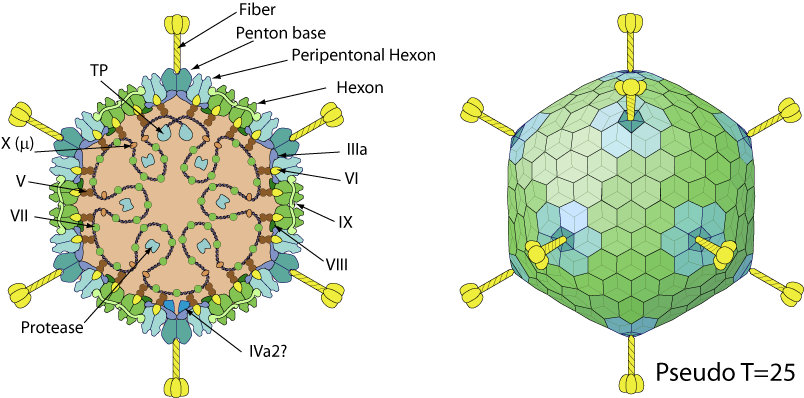Unresolvable Taxon:100953 (taxid:100953)
VIRION

Non-enveloped capsid with a pseudo T=25 icosahedral symmetry. The capsid diameter is about 90 nm. The capsid shell consists of 720 hexon subunits arranged as 240 trimers and 12 vertex penton capsomers each with a fiber protruding from the surface.
- Double jelly roll-fold major capsid protein [Hexon]
- Single jelly roll-fold penton capsid protein [Penton]
GENOME
Monopartite, linear double-stranded DNA of 30 kb encoding about 30 proteins. The genome has terminally redundant sequences which have inverted terminal repetitions (ITR). The terminal protein (TP) is covalently attached to each end of the genome.
GENE EXPRESSION
Transcription is nuclear, in two phases; early (replication), late (virion assembly). All genes are transcribed by host RNA pol II. Genes transcribed by RNA pol II give rise to multiple mRNA that are produced by alternative splicing and use of different poly(A) sites.
ENZYMES
- DNA-directed DNA polymerase B [POL]
- Protein-primed terminal transferase [POL on TP]
- Adenain (Peptidase C5) [Protease]
REPLICATION
NUCLEUS
- Attachment of the viral fiber glycoproteins to host receptors mediates endocytosis of the virus into the host cell and fiber shedding.
- Disruption of the endosome by lytic protein VI releases the viral capsid in the cytosol.
- Viral penetration into host nucleus.
- Transcription of early genes (E genes) by host RNA pol II, replication of the DNA genome by DNA strand displacement in the nucleus.
- Transcription of late genes (L genes) by host RNA pol II, mostly encoding for structural proteins.
- Assembly of new virions in the nucleus.
- Virions are released by lysis of the cell.
Matching UniProtKB/Swiss-Prot entries
(all links/actions below point to uniprot.org website)33 entries grouped by strain
28 entries
Snake adenovirus serotype 1 (SnAdV-1) reference strain
3 entries
Ovine adenovirus D serotype 7 (isolate OAV287) (OAdV-7) (Ovine adenovirus 7) reference strain
1 entry
Bovine adenovirus 4 (BAdV-4) reference strain
1 entry
